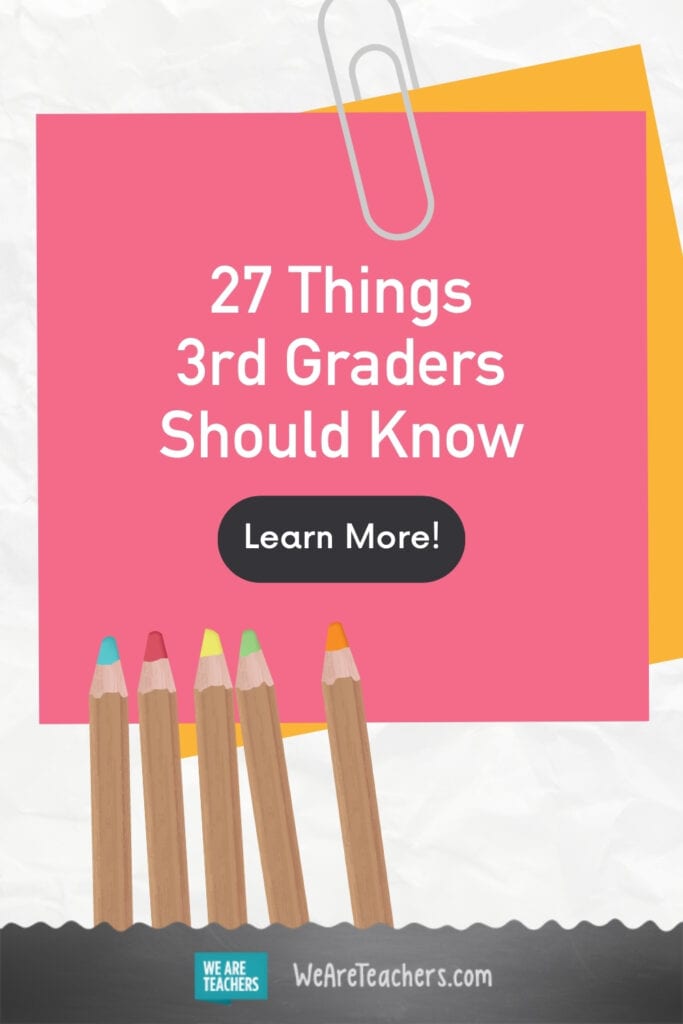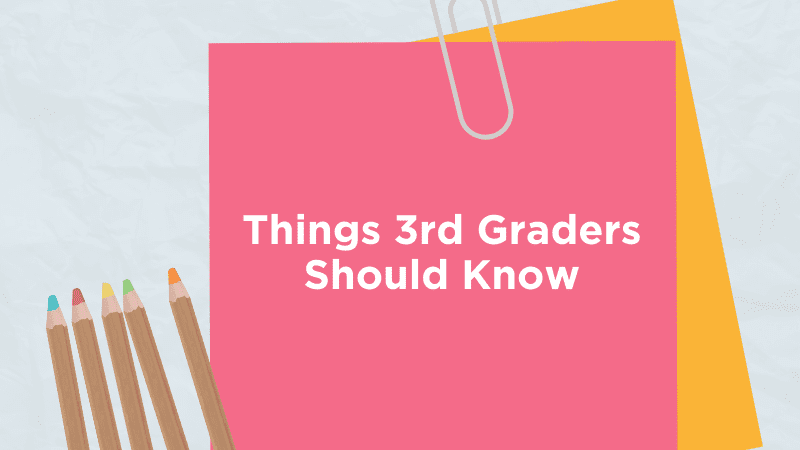What makes a well-rounded education for a third grader? Let’s take a look at the various things every third grader needs to know by the end of the year in reading, writing, math, science, history, art, and music. Regardless of which curriculum you use, if you’re covering most of these, then you’re well on your way to helping your students have a bright and knowledgeable future!
Reading, Writing, and Language
1. Understand different types of sentences and the main parts of speech.
To become a stronger writer, it helps to understand different types of sentences and parts of speech. Students should know the four main types of sentences: declarative (statement), interrogative (question), imperative (command), and exclamatory (excited), as well as the 8 main parts of speech (noun, pronoun, verb, adjective, adverb, preposition, conjunction and interjection). Consider starting with The Best Parts of Speech Videos on Youtube and make it fun using games and technology!
2. Analyze poetry.
Third graders are expected to read and understand grade-level poetry. This includes analyzing poetic structure, knowing words like “stanza” and explaining how different parts of a poem are connected. Third-grade appropriate and engaging poems can be difficult to find. Try starting with these 70 must-share poems for your elementary classroom.
[contextly_auto_sidebar]
3. Learn how affixes work.
It might seem like a fancy term for third graders, but affixes are definitely a concept they can conquer this year. In fact, they may even come with some background knowledge from earlier grades. Using context clues to decipher word meanings is a major focus in third grade. and proficiency in affixes can help! Take apart words with prefixes (like reuse, untie and disappear), suffixes (like friendly, teacher, and homeless), and identify root words as a group to help students understand how affixes change word meanings. Then challenge them to find more examples! We love these tips, tricks, and tools for teaching roots and affixes.
4. Learn how to do basic research.
Third grade is an excellent year to start teaching research skills in relation to writing since there is an emphasis on reading informational text and actually using text features and search tools. However, it’s too soon to just let them “Google” on their own. Instead, focus on a unit of study, and give them a few teacher-approved websites they can go to for their research. For instance, if you’re doing an animal unit, websites like the San Diego Zoo and National Geographic Kids are excellent places to start. Have them look up facts and make some bullet points on their assigned animal before they start writing.
5. Write a story with a beginning, middle and end.
This is about the age when students really need to be able to put a story together sequentially. Overall pacing will come a little later, but they should start making sure all of their stories have a basic beginning, middle and end. The beginning should include an introduction to the characters and setting, the middle should present the problem and the end should wrap it up with a plausible solution. Here’s a link to a free printable that students can use while organizing their story. Have them read their stories to each other and use a checklist to evaluate if they have a beginning, middle, and end.
6. Engage in collaborative discussions.
By third grade, students should be able to carry on a conversation with their peers on academic topics. At this age, students are capable of effectively and respectfully agreeing, disagreeing, asking questions, and adding-on to each others’ ideas. Try using sentence frames, hand gestures, and talk moves to frontload the language needed for success with academic discussions. The ultimate goal is for the teacher to be able to step back and let the conversation flow! For other fun ways to engage students in discussion, check out these 10 fun alternatives to think-pair-share.
Geography and History
7. Have a basic understanding of maps.
Yes, knowing north, south, east and west is essential, but it’s important that your students know how to put that knowledge into practice. Try a Geography Challenge and turn it into a game. With this, you’ll have students work in pairs. One student should tell the other a state, city or country to find, along with directionals like “Which country starts with a T, is north of Africa, and east of Greece,” or “This state is on the west coast and south of Oregon.” Check out our list of map skills activities!
8. Know what it means to be a good citizen.
Teaching citizenship and its value can produce children with a stronger commitment to doing good. According to Young Citizens, “Citizenship education involves developing the knowledge, skills and confidence to enable people to make their own decisions and to take responsibility for their own lives and communities. And in many countries – where democratic society and its institutions are facing threats – citizenship education is becoming increasingly important.” Respect, awareness, tolerance, honesty, compassion, responsibility, and empathy are all themes that citizenship education can cover.
9. Learn about and compare diverse cultures.
By third grade, students are expected to be able to recognize that Americans are people who have diverse ethnic origins and traditions who all contribute to American life. So, they need to learn about and compare the languages, foods and traditions of various groups. Consider finding stories that represent your own students’ backgrounds and identities, then build background knowledge of those cultures and traditions for all students before diving into the texts. To help, check out this list of multicultural fairy tales and folktales from the New York Public Library.
10. Explain change over time.
How has technology changed in the last 100 years? What about school? It’s important that by third grade, our students understand that life hasn’t always been this way. There is also a cross-curricular connection here as third graders are expected to know and use language associated with time (long ago, recently, today, etc.) and sequence (first, then, now, etc.).
11. Learn about Native American cultures.
Start by learning about different Native American cultures, people and ways of life in different regions. Help your students understand that tribes and cultures vary a great deal from one area to the next. For example, compare and contrast the Hopi and Zuni tribes in the Southwest to the Mohican and Iroquois in the Eastern Woodlands. Check out this free downloadable lesson about Native Americans: Regions and Cultures from Core Knowledge.
Art and Music
12. Understand 2-D and 3-D.
The difference between two-dimensional art (height, width) and three-dimensional art (add depth) is fun for students to examine in artworks and to put into practice.
13. Identify warm vs. cool colors.
Why are some colors called warm and others cool? In third grade, it’s time to move from just primary colors to learning more about the color wheel and basic color theory, like warm colors can signify energy and cool colors bring calm. Check out these Scholastic resources for color-filled activities!
14. Learn about tints and shades.
Speaking of basic color theory, learning about tints (a mixture of a color and white) and shades (a mixture of a color with black) is a third grade staple. What’s more fun than mixing paint to create new colors? From listening to songs about tints and shades to creating monochromatic art projects, expanding students’ knowledge and abilities with colors can be fun!
For more ideas: 30 best third grade art projects that teach and inspire
15. Know that art and music reflect and influence culture.
Art and music have the power to culturally, morally, and emotionally influence our society. Belinda Huang says, “Culture and music flow together. What our parents used to dig, kids of today would deem as lame. And in a few years, the music we think is cool now will probably be outdated. It’s nothing against the music. It’s just a representation, a manifestation of what’s constantly changing around us.” Try analyzing different types of art and music from various time periods and cultures to help students gain insight.
16. Keep a steady beat (and understand meter).
Beat and meter have many cross-curricular benefits, and my music teacher calls them “the math of music.” These skills can help children identify and repeat patterns, improve gross and fine motor skills, and they’ve even been linked to early language and literacy skills. Have your third graders try picking out a beat in a piece of music or song and clapping or tapping their feet along with it. For more ideas, here are 5 ways to teach steady beat.
17. Understand the different instrument families.
It won’t be long before many students have the opportunity to pick out an instrument to play in band. Introduce them to the families of musical instruments: strings, brass, woodwinds and percussion. Listen to recordings and watch videos to help them become familiar with the sound of instruments in each family. Thanks to Mrs. King’s Music Class for this idea for teaching instruments (pictured below).
Math Skills
18. Understand place value up to the thousands.
By the time they get to third grade, most students already have at least some place value skills. However, simply understanding what each digit represents in a number is not enough for third grade. They need to be able to add and subtract tens, hundreds, and thousands and round numbers to each place (i.e., round 3,415 to the nearest hundred). Start with a review of the place value concepts they learned in second grade, then build upon them. Cassie Smith has an excellent blog on teaching rounding in third grade.
19. Make change from a dollar bill.
Bust out your play money and encourage students to make change in the simplest way possible. You can even use cupcake liners (like the idea below from blogger Life Over C’s) to make it fun and stay organized. Or, consider starting a school or classroom store where students can earn artificial money and then purchase rewards. Check out How to Start a School Store for more tips and ideas!
20. Understand weight and volume.
Hands-on activities are key to helping students understand how to weigh and measure in both metric and U.S./Imperial units. Have them record their results and learn to use common abbreviations such as g and oz. Also consider including non-standard weights.
21. Solve problems with time and temperature.
Students should be able to solve problems that ask them to add and subtract in units of time or temperature. How much time has passed since class started? How many degrees warmer is it today than yesterday? Students can graph their day, citing what they did and how the temp changed throughout the day. Here are 15 hands-on ways to teach telling time.
22. Master multiplication and division within 100.
At this age, students should know their math facts factors up to 10 x 10. They should also be able to mentally multiply by tens, hundreds, and thousands. Try mixing multiplication facts in with word problems too. Make it fun with 35 fun, hands-on ways to teach multiplication and 35 engaging activities for teaching division.
23. Learn fractions, fractions, fractions!
Third grade is often when students jump into fractions for the first time, and it can be tricky! Identifying fractions, understanding fraction vocabulary, comparing fractions with like-denominators or like-numerators, and identifying equivalent fractions with denominators of 2, 3, 4, 6, and 8 are essential foundational skills before they move on to fourth grade, and it just gets more complicated. Make it fun with our favorite fun and free fraction games for kids!
Science
24. Classify animals.
While third graders don’t need to get into details of genus and species, it’s good to start introducing the concept of animal groupings early on—for example, cold-blooded vs. warm-blooded and vertebrates vs. invertebrates. You can then look at characteristics or traits of different groups of vertebrates: fish, amphibians, reptiles, birds and mammals. Get a free lesson on the classification of animals right here.
25. Explain Earth in the solar system.
Space is a fascinating topic for both kids and adults! By the end of third grade, students should be able to explain that the sun is a star, Earth’s gravitational pull and how it affects us, words like orbit, tilt and revolve, and why sometimes we can see our shadow. NASA even has a Kids’ Club and NASA Stem for Students with tons of resources for K-4!
26. Understand man-made threats to the environment.
These can be some serious topics, but kids need to know what’s happening in the natural world around them, including man-made threats like air pollution and water pollution. As they learn about these, be sure to explore how they can be part of the solution.
27. Understand how weather, climate and the water cycle are connected.
Most students probably come to third grade with some knowledge (and definitely some personal experience with) weather. In third grade, it’s more about how weather and climate are related and how they connect to the water cycle. Kids are always surprised when we tell them there is only so much water on Earth, and that amount will never change. Check out our climate change activities here.
There you have it, the 27 things every third grader needs to know. Do you have any other thoughts? Share in the comments below! Plus, make sure to check out everything you need for the 3rd grade classroom!


